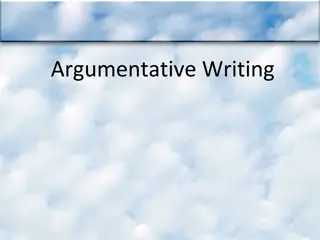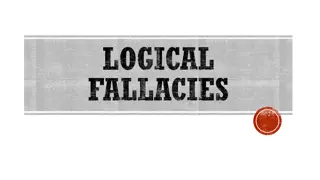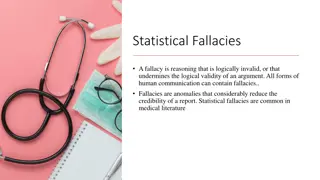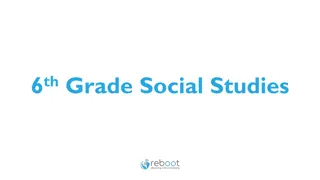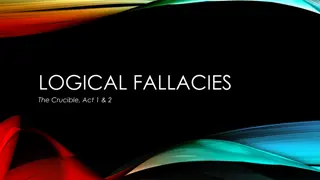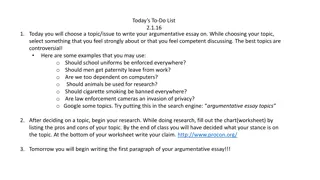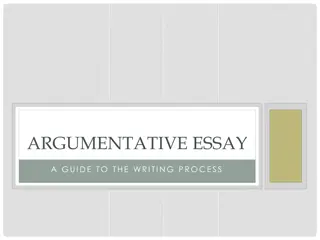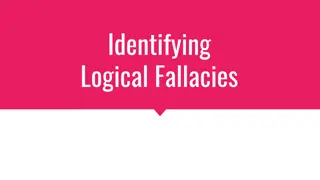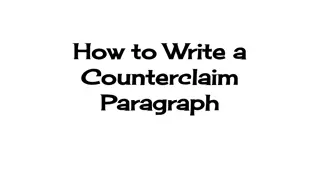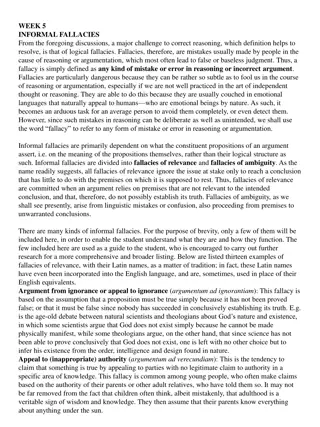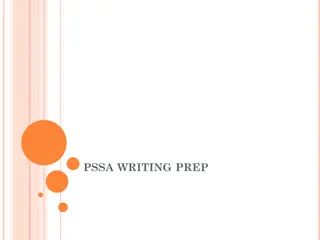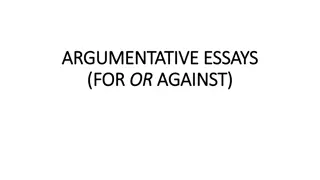Fallacies in Argumentative Techniques
Dive into the world of fallacies in argumentation, exploring the nuances of Ethos, Pathos, Logos, and various rhetorical devices. Uncover the pitfalls of faulty Ethos and Pathos, dissecting examples such as Poisoning the Well and Appeal to Pity. Enhance your critical thinking skills by recognizing and avoiding common fallacies that can weaken an argument's validity.
Download Presentation

Please find below an Image/Link to download the presentation.
The content on the website is provided AS IS for your information and personal use only. It may not be sold, licensed, or shared on other websites without obtaining consent from the author.If you encounter any issues during the download, it is possible that the publisher has removed the file from their server.
You are allowed to download the files provided on this website for personal or commercial use, subject to the condition that they are used lawfully. All files are the property of their respective owners.
The content on the website is provided AS IS for your information and personal use only. It may not be sold, licensed, or shared on other websites without obtaining consent from the author.
E N D
Presentation Transcript
Argument is made up into 3 different parts And you already know the first two! Argumentative Techniques Ethos, Pathos, Logos Rhetorical Devices Anaphora, imagery alliteration, symbolism, etc. Fallacies Everything today!
Whats a fallacy? A fallacy is an error in reasoning Fallacies in an argument can make it totally invalid But, if the audience doesn t realize a fallacy is used, they might just believe whatever the writer/speaker asks them to! Fallacies can be found in each part of the triangle (ethos, pathos, logos)
Faulty Ethos What is ethos? The author s credibility! Two types: 1. Poisoning the Well (name calling) 2. False Credibility
Poisoning the Well (can include name calling) An attack on the person, not the issue How is President Clinton supposed to help the US economy? He cheated on his wife! The president and his economic policies have nothing to do with his wife.
False Credibility The author/speaker may be an authority in one field, but might know nothing about another Example: An actor could be great at acting, but not know anything about being a doctor or the science behind body odor
Faulty Pathos What s pathos? Emotions of the audience! Two types: 1. Appeal to pity (ad misericordiam) 2. Bandwagon
Appeal to Pity (ad misericordiam) Making the audience agree with the message by making them feel sorry for the writer/speaker Example: I know that the project that is worth 20% of my grade is due today, but I would really like an extension. I don t have it because my goldfish was sick, I didn t wear pink on Wednesday so I couldn t eat lunch with my friends, I can t get the Let it Go song out of my head and I think my parents love my brother more than they love me. Can I turn it in tomorrow?
Bandwagon Claiming that the idea is good because it is possible People don t want to feel left out, so they ll join in (Everybody else is doing it!)
Faulty Logos What s Logos? Logic! 5 types 1. Sweeping generalization 2. Hasty Generalization 3. Oversimplification 4. Slippery Slope 5. False Analogy
Sweeping Generalization (Dicto Simpliciter) The author describes a situation in a manner that is too broad Everyone failed the test! Look for words like all, everyone, every time, anything, no one, and none Everyone who lives in Oregon is a hipster Oil, Oil. Oil. Oil.
Hasty Generalization An assumption is made based on too little evidence Example: Alex Rodriguez used steroids during his baseball career so that means, all baseball players must use steroids.
Sweeping vs. Hasty Generalization Sweeping Generalization=Everyone One All of this applies to one person Hasty Generalization=One Everyone One person made everyone like this
Oversimplification The author describes a complex situation as being much simpler than what it is Could be combined with another fallacy Example: World hunger can be solved by giving everyone food.
Slippery Slope The author argues should one event occurs, so will lots of other events. There is no proof that the harmful events are caused by the first event Direct TV: http://www.bing.com/videos/search?q=direct%20tv%20commercial&qs=n&form=QBVR&pq =direct%20tv%20commercial&sc=8-20&sp=- 1&sk=#view=detail&mid=3CCE0F46DA327AF5AB753CCE0F46DA327AF5AB75
False Analogy The author incorrectly makes an analogical (comparison) connection between two unconnected items I think you should give me credit for this class because Joe comes to class only three days out of the week and I m here everyday. You passed everyone else in the class so I should receive credit like my fellow classmates.







